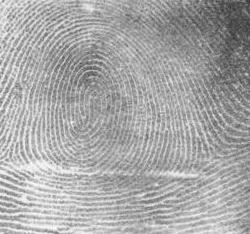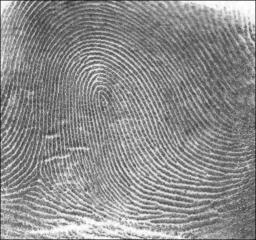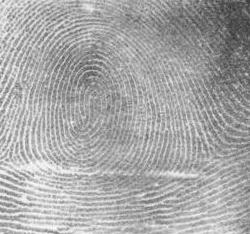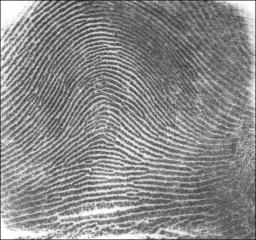How can I take fingerprints?

Fingerprint whorl (NIST database, Public Domain)
In this activity learn how to collect fingerprints, about the patterns in fingerprints and why fingerprinting is so useful!
What You Need
- White paper
- Graphite pencil
- Clear adhesive tape
- Wet wipes
- Magnifying glass
- Fingerprint patterns (see below)
What To Do
- Trace your hand (left or right - just remember which one!) on the paper.
- Rub your pencil into the corner of your paper until a glossy black patch of graphite is made.
- Rub the pad of one finger from the hand you just traced in the graphite patch. (Do not rub too hard or the ridges of the fingerprint will flatten out.)
- Take a piece of tape, stick it on the finger and rub to pick up graphite.
- Lift tape off the finger.
- Place the tape, sticky side down on the paper, on the appropriate traced finger, in the outline of your hand. Repeat for all fingers and the thumb.
- Take a magnifying glass and examine the prints. Which pattern do you see on each finger? Is every finger the same?
- Clean your fingers with the wet wipes or with soap and water to avoid leaving finger marks elsewhere.
Discovery
In their DNA, each individual has a pair of genes for each of their traits; one gene is inherited from each parent. Traits are things like hair colour, eye colour, etc. These pairs of genes determine our unique characteristics, such as the pattern of our fingerprints. Fingerprints are unique, even among identical twins!
Most fingerprints have patterns of ridges separated by valleys. In the valleys, there are small holes. Each of these holes is a small pore through which oil, sweat and moisture oozes from the gland within. When we touch objects, we leave behind a trace of oil and sweat in the same pattern as our fingerprint (just like a muddy shoe would leave behind a print that corresponds to the pattern on the sole). The ridges give our fingers a rough surface, increasing friction and allowing us to grab things!
There are three basic patterns found in fingerprints: loop, arch, and whorl. A fingerprint with more than one of these designs is a composite fingerprint.
Loop Pattern

Whorl Pattern

Unlike traits like hair and eye colour, fingerprints are a great way for telling people apart because everyone's fingerprints are unique. Fingerprints can stay on objects for a very long time if the surface they are on is not cleaned after being touched. This can be observed on old silver spoons, or other cutlery, glasses, windows, etc. Even injuries to the finger pads, such as minor burns and cuts, will not permanently alter the fingerprint pattern. Once new skin grows back, it will once again assume the same ridge pattern.
Fingerprinting has been used for a long time by government agencies, like the police, to identify criminals. Fingerprints can also be used to identify people who have gone missing. Dactyloscopy is the practice of using fingerprints to identify someone. More recently, many electronic devices have been fitted with fingerprint recognition features that allow the user to unlock the device and authorize online purchases.
- Try taking fingerprints from both hands. What is the same about them? What is different? Are your prints symmetrical?
- Have a look at your toes. Do you see ridges on those as well? Try taking a toe print! What do you notice is the same or different from your fingerprints?
For more information on this topic check out these Let's Talk Science resources:
- CSI Lac-Mégantic: How are victims identified after a disaster? (STEM on Context) - Learn about forensic pathology and other methods scientists use, like analysing the skeletal system, to identify the dead after a disaster.
What’s happening?
In their DNA, each individual has a pair of genes for each of their traits; one gene is inherited from each parent. Traits are things like hair colour, eye colour, etc. These pairs of genes determine our unique characteristics, such as the pattern of our fingerprints. Fingerprints are unique, even among identical twins!
Most fingerprints have patterns of ridges separated by valleys. In the valleys, there are small holes. Each of these holes is a small pore through which oil, sweat and moisture oozes from the gland within. When we touch objects, we leave behind a trace of oil and sweat in the same pattern as our fingerprint (just like a muddy shoe would leave behind a print that corresponds to the pattern on the sole). The ridges give our fingers a rough surface, increasing friction and allowing us to grab things!
There are three basic patterns found in fingerprints: loop, arch, and whorl. A fingerprint with more than one of these designs is a composite fingerprint.
Loop Pattern

Whorl Pattern

Why does it matter?
Unlike traits like hair and eye colour, fingerprints are a great way for telling people apart because everyone's fingerprints are unique. Fingerprints can stay on objects for a very long time if the surface they are on is not cleaned after being touched. This can be observed on old silver spoons, or other cutlery, glasses, windows, etc. Even injuries to the finger pads, such as minor burns and cuts, will not permanently alter the fingerprint pattern. Once new skin grows back, it will once again assume the same ridge pattern.
Fingerprinting has been used for a long time by government agencies, like the police, to identify criminals. Fingerprints can also be used to identify people who have gone missing. Dactyloscopy is the practice of using fingerprints to identify someone. More recently, many electronic devices have been fitted with fingerprint recognition features that allow the user to unlock the device and authorize online purchases.
Investigate further
- Try taking fingerprints from both hands. What is the same about them? What is different? Are your prints symmetrical?
- Have a look at your toes. Do you see ridges on those as well? Try taking a toe print! What do you notice is the same or different from your fingerprints?
For more information on this topic check out these Let's Talk Science resources:
- CSI Lac-Mégantic: How are victims identified after a disaster? (STEM on Context) - Learn about forensic pathology and other methods scientists use, like analysing the skeletal system, to identify the dead after a disaster.
